Introduction to Scales
A Scale is a specific set of notes played one at a time built from whole step and half step intervals (if
intervals have not been committed to memory, revisit and review the interval’s chapter). Scales are found everywhere in music, in vocal
melodies, orchestration scores, and all of those unforgettable solos and riffs. Scales are used to add melodic and harmonic interest. This
section will demonstrate how to build and use several of the most common scales and modes, followed by an extensive list showing a large
selection of scale types to explore and apply to daily practice and song writing. After mastering this section on scales, songs will be heard
with a new and creative perspective!
Scale Construction
There are many types of scales and the most common scales will be taught. Each scale type will have its own unique quality, which will allow
a greater versatility of scale usage in songs and solos. The most common and widely used scale types will be shown with many examples
demonstrating how these various scale types are constructed.
Scales can be constructed using several different methods. One method is to use the universal Major scale (Do, Re, Mi, Fa, So, La, Ti)
to build any other scale. With this method, the seven notes in the major scale are listed as scale steps or degrees (1, 2, 3, 4, 5, 6, 7).
These scale steps can be sharped or flatted to reflect the note changes from the major scale to the scale being built. Musicians use step
numbers as a placeholder to refer to a position in a scale without having to specify any notes. For example, the 3rd step would refer to
the 3rd note in that scale, and a b3rd step would refer to the 3rd note in the scale flatted a half step. Also, these step numbers are
sometimes written using roman numerals (I, II, III, IV, V, VI, VII). Another method is to build a scale by modifying a familiar or nearby
scale because both scales will share many common notes. This method is much faster than building the scale from scratch. The last approach
is to use whole (W) and half step (H) intervals starting from the scale’s Root note to construct a scale. The root (tonic) note is the
first step in a scale.
The first scale to construct is the Chromatic scale. This scale is made up of all half step intervals; therefore, the chromatic scale
is made up of all 12 notes in music (A, A#/Bb, B, C, C#/Db, D, D#/Eb, E, F, F#/Gb, G, G#/Ab). Remember, from B to C and E to F there
are no sharps or flats in between them. Because the chromatic scale uses all 12 notes in music (western music), any scale can be
constructed using the chromatic scale’s notes.
The next two scale types will use 7 notes per scale. The first 7 note scale is the Major scale. The scale steps (degrees) of a
major scale would simply be 1, 2, 3, 4, 5, 6, 7. This scale formula will be used to create many other scale types in this section,
and also help construct chords in the chord’s lessons. By comparing the notes in C major (C, D, E, F, G, A, B) with the step
numbers (1, 2, 3, 4, 5, 6, 7), notice that each note is associated with a scale step (1C, 2D, 3E, 4F, 5G, 6A, 7B). If a G major is
constructed, the step number and notes would be 1G, 2A, 3B, 4C, 5D, 6E, and 7F#. So, a different major scale is associated with a
new set of notes with each step number. To build a major scale using whole steps and half steps, the combination would be
W-W-H-W-W-W-H. If a scale uses W+H or H+W, this indicates a minor third interval because a whole step and half step are combined. This
scale is the most important scale and should be practiced until fully memorized. Figure 1 below shows a C major scale.
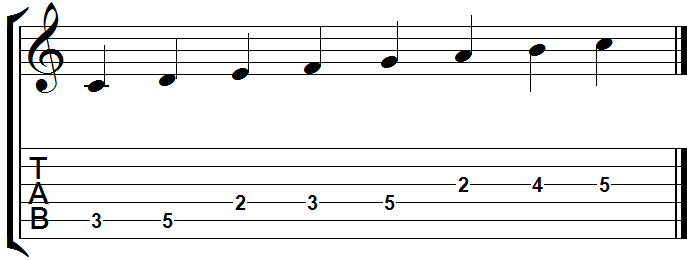
Figure 1 -
C Major Scale
The second scale is the Minor scale. This scale can be built from the major scale or from the ground up using whole steps and half
steps. When using the major scale formula (1, 2, 3, 4, 5, 6, 7), flat the third step, sixth step, and seventh step to construct the
minor scale (1, 2, b3, 4, 5, b6, b7). For example, the C minor scale has the notes C, D, Eb, F, G, Ab, and Bb. An alternative to
using the major scale, a minor scale can be constructed using whole step and half step intervals. The combination is
W-H-W-W-H-W-W. This minor scale should be practiced until fully memorized in every key signature because it will also be used to help
build several other scales. Figure 2 below shows the C minor scale.
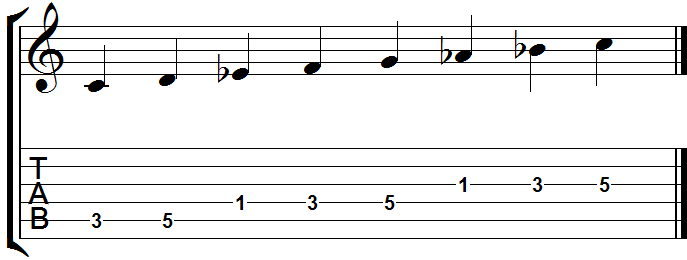
Figure 2 -
C Minor Scale
The next two scales will be 5 note Pentatonic scales. Pentatonic scales are some of the most popular scales and are used in a wide variety of music
genres. The focus will be on two types of pentatonic scales, the major and minor. The Major Pentatonic scale can be constructed easily with the major
scale by simply removing the fourth and seventh step notes. The formula for the major pentatonic scale is 1, 2, 3, 5, 6. The whole step and half step
combination is W-W-H+W-W-W+H. Figure 3 is a C major pentatonic scale.
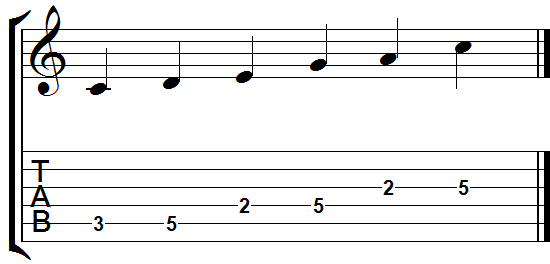
Figure 3 -
C Major Pentatonic Scale
The Minor Pentatonic scale is constructed from a minor scale without the second and sixth steps. The minor pentatonic scale formula
is 1, b3, 4, 5, b7. The whole step and half step combination is W+H-W-W-H+W-W. Figure 4 below is a C minor pentatonic scale.

Figure 4 -
C Minor Pentatonic Scale
The Dorian scale is the next scale to learn how to build. This scale has two alterations from the major scale. The third step and
the seventh step are both flatted. Therefore, the formula is 1, 2, b3, 4, 5, 6, b7. Another method of creating a dorian scale is by
altering the minor scale. Remember, the minor scale’s formula is 1, 2, b3, 4, 5, b6, b7. The only difference between the dorian
scale and the minor scale is the sixth step note. Simply raise that minor scale’s sixth degree note a half step up to get a dorian scale. To
construct a dorian scale with whole steps and half steps, use the combination W-H-W-W-W-H-W. The next page is a C dorian scale in
Figure 5.

Figure 5 -
C Dorian Scale
The next scale is the Phrygian scale and its formula is 1, b2, b3, 4, 5, b6, b7. This scale can be created from a minor scale by
taking the minor scale (1, 2, b3, 4, 5, b6, b7) and then flatting the second step. To build the phrygian scale with whole steps and
half steps, the combination is H-W-W-W-H-W-W. Figure 6 is a C phrygian scale example.
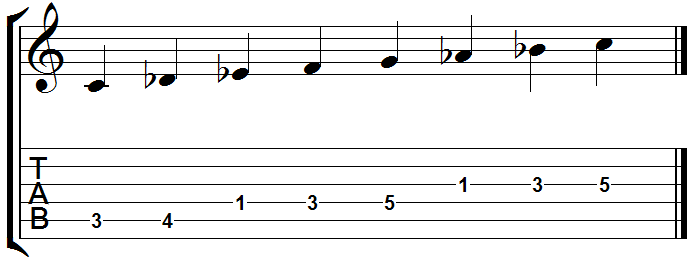
Figure 6 -
C Phrygian Scale
The next scale is the Lydian scale. This scale is very similar to the major scale. The only difference is the fourth step note must
be sharped (1, 2, 3, #4, 5, 6, 7). For example, to build a C lydian scale, use the notes from the C major scale (C, D, E, F, G, A, B)
and raise the fourth step note (C, D, E, F#, G, A, B). So, the difference is between the C major and C lydian scales is the F and
F#. To build this scale using whole and half step intervals, use the combination W-W-W-H-W-W-H. Figure 7 below shows a C lydian scale.
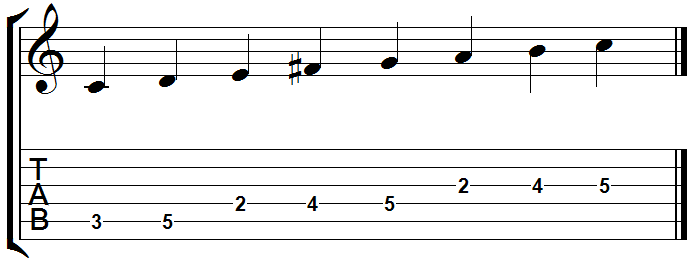
Figure 7 -
C Lydian Scale
Another similar scale to the major scale is the Mixolydian scale. With the mixolydian scale, simply flat the seventh step note from the
major scale. This will produce the formula 1, 2, 3, 4, 5, 6, b7. So, a C mixolydian scale will have the notes C, D, E, F, G, A, Bb.
The whole and half step interval combination is W-W-H-W-W-H-W. Figure 8 demonstrates a C mixolydian scale.
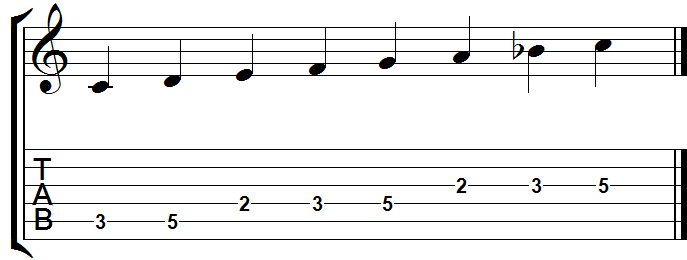
Figure 8 -
C Mixolydian Scale
The last scale is the Locrian scale. The locrian scale flats all steps except the first and fourth. So, the formula is
1, b2, b3, 4, b5, b6, b7. Constructing the locrian scale from the phrygian scale (1, b2, b3, 4, 5, b6, b7), simply add a flat fifth
step. The whole step half step combination is H-W-W-H-W-W-W. Figure 9 below shows a C locrian scale.
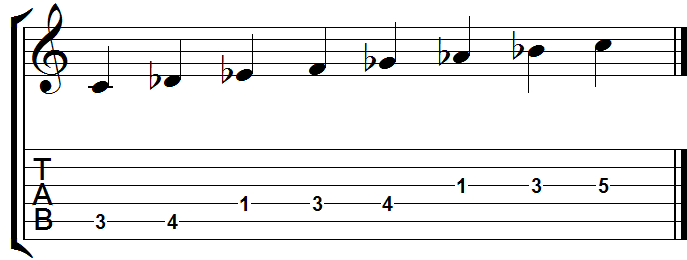
Figure 9 -
C Locrian Scale
The following PDF link, 55 Scale Types, shows a long list of many common and exotic scale names, their formula, and notes in the Key of C. This
table is a great reference while studying and practicing all these scales. It will take some time before all these scales
become memorized. Remember to use similar scales to help remember the more difficult scales by identifying the small
differences between the similar scales.
55 Scale Types - This PDF requires Adobe Reader